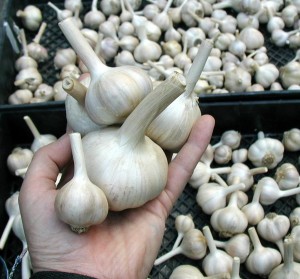After harvesting the garlic plants from the garden, what’s next? Drying, of course, and prepping for storage.
The garlic plants were moved into the garage late in the day they were harvested to protect them from rain and the morning dew. We’re trying to dry out the plants so any moisture isn’t good at this stage.
Garlic plants were dug up and laid out on a sheet to dry in the shade for part of the day. By having the plants on a sheet it made it easy to transport them easily into the garage. The ends of the sheet were gathered into a big bundle for carrying and just as easily unfurled on the work bench in the garage. Sheets helped to contain the dirt and loose leaves, too.
The garlic was laid out in mostly a single layer to dry some more. The plants were adjusted here and there for a couple of weeks so that all plants would dry out.
After about two weeks time the outer leaves were stripped away and the tops cut back to 6-8 inches long. The plants were left to dry again.
About a week later another set of outer leaves were stripped from the bulbs so that a white outer layer remained and the dirt removed. Roots were trimmed with scissors and the tops or hard necks were trimmed down to 2-3 inches long. The bulbs were laid on planting trays for continued curing.

Any of the cloves that were exposed to the air were either taken into the kitchen to be used soon or poked into the garlic patch in the garden.
An improvement we could make for next year would be to selectively pull some of the small garlic plants that come up so that other bulbs would be able to grow larger. A more uniform harvest would be possible if each garlic plant had a little more room to grow. Any of the pulled sprouts could be cooked to our delight. Anyone for tasty broiled garlic sprouts?

Now, we’re looking forward to cooking with all that garlic!